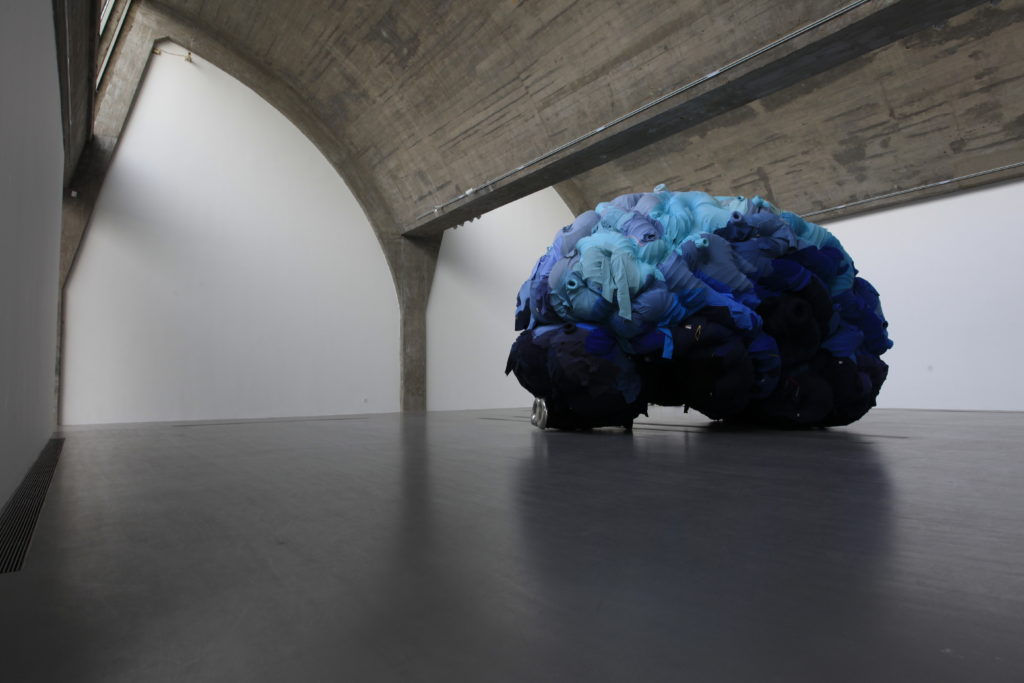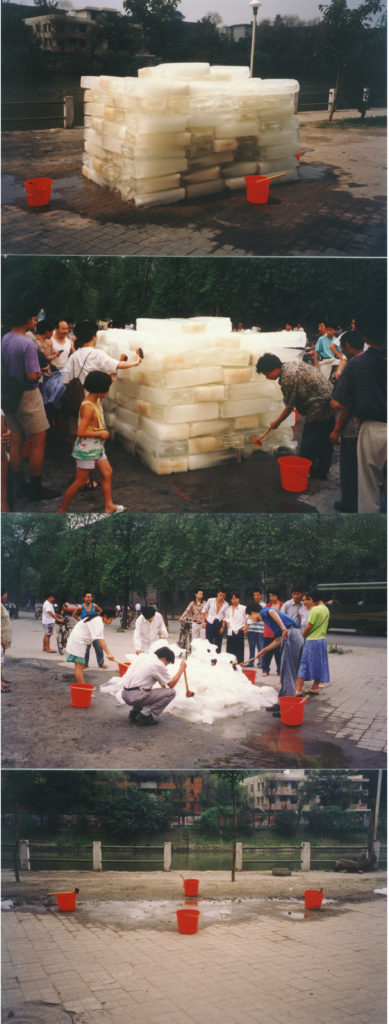In partnership with the non-profit organisation Art of Change 21, which connects contemporary art and major environmental issues, ACA project was honoured to ask questions to artist Yin Xiuzhen (b.1963, Beijing, China), with the kind help of PACE gallery.
Yin Xiuzhen draws her inspiration from the rapidly changing cultural environment of her native Beijing. She uses secondhand objects like clothing, shoes, and suitcases to create sculptures and installations which operate as sculptural documents of memory, alluding to the lives of individuals who are often neglected in the drive toward rapid development, excessive urbanisation, and the growing global economy.

ACA project & Art of Change 21 : Your work raises awareness of the effects of globalization, including its consequences on the environment and urbanization. How did these issues appear in your work?
Yin Xiuzhen : In the 1990s, the end of the Cold War moved the world from confrontation to integration. The rise of the internet and the easier access to transportation increased international communication. Travel, drastic changes in the natural environment, and the impact of large-scale urbanization has changed people’s lives. I wanted to express my own understanding of the impact of globalization through art. My works “Washing the River” and “Abandoned Capital”, both made in the 1990’s, deal with issues of environment and urbanization. Since 2001, I have been working on the “Portable City” series. During my city travels, I have collected used clothes that have been worn by the inhabitants, allowing me to connect with the real-life experiences of locals and their livelihoods. I sculpt my own representation of the city and its inhabitants by sewing these clothes into a portable suitcase, so these sculptures can easily travel. So far “Portable City” has been created in 43 different cities around the world. Each creation is a form of communication between the city and the rest of the world. With this work, I am able to grasp these different cultures, and the daily life is embodied through the clothes people wear. These garments are mixing global issues and people’s intimacy, they are symbols of globalization and urbanization. They speak about climate, and they also carry the emotions and feelings of the individuals who wore them.
Why are textiles one of your main materials?
I use a large amount of used clothes as materials for my creations. Although these are textiles, I value the invisible but perceptible things attached to these textiles. I define clothes as the “second skin of humans”—it being one of of our “social skins”. Connected to the “social skin” and soft fabric materials, the garments say a lot about social division of labor, aesthetic trends, and so on. Clothes reveal many things about a person: the body, gender, age, style, and standard of living, each aspect portraying a single form of communication. Once worn, each piece of clothing carries the importance of the wearer’s experiences, memories and life values, telling an invisible story from the time they were worn. Alone, the textiles convey one aspect of the work, but it is the soul of the textiles that conveys my understanding of the world.

Your interventions are often participative – for “Washing the River” (1995) you invited viewers to wash a bloc of frozen polluted water, for instance – and immersive – “Collective Subconscious” 2007, “Thought” 2009. Why are these dimensions important to you?
The human element is a crucial factor in that people need to support, communicate, and co-exist with each other. I hope that different pieces of work can unite us in an artistic way, allowing viewers to see new perspectives other than just the “dimension of the look”.
How is your work received in China?
Great changes have taken place in China since the 1990s, and the acceptance of contemporary art has changed dramatically. Each time I present my work, I still get a lot of support and participation. The public’s awareness of environmental protection and participation in social environmental transformation is constantly improving, while the influence of contemporary art among the public continues to grow.
How would you define your role as an artist – if an artist has to have one?
Everyone’s purpose and role is quite different, however as an artist, it is our role to tell the tale of diversity by enriching each story. With each artist, creativity and creative freedom is what everyone sees, but kindness, tolerance, and responsibility to society play equally important roles.
What contemporary issues are you most engaged in at the moment?
How a world that has been divided by differing values, exacerbated by the pandemic, can return to freedom. How to find practical solutions and directions to the problem of the world’s environment and climate deterioration.
What are your future projects?
I am currently working on a solo exhibition at the Shanghai Museum of Glass.
Interview by Lou Anmella-de Montalembert & Alice Audouin – November 2021

En partenariat avec l’association Art of Change 21, qui relie l’art contemporain et les grands enjeux environnementaux, ACA project a eu l’honneur de poser des questions à l’artiste Yin Xiuzhen (née en 1963, Pékin, Chine), avec l’aide précieuse de la galerie PACE.
Yin Xiuzhen puise son inspiration dans l’environnement culturel à l’évolution rapide de sa ville natale, Pékin. Elle utilise des objets de seconde-main comme des vêtements, des chaussures et des valises pour créer des sculptures et des installations qui fonctionnent comme des documents sculpturaux incarnant la mémoire, faisant allusion à la vie d’individus souvent négligés dans la course au développement rapide, à l’urbanisation excessive et à la croissance de l’économie mondiale.
ACA Project & Art of Change 21 : Votre travail sensibilise aux effets de la mondialisation, notamment à ses conséquences sur l’environnement et l’urbanisation. Comment ces enjeux sont-ils apparus dans votre travail ?
Yin Xiuzhen : Dans les années 1990, avec la fin de la Guerre Froide, le monde est passé de la confrontation à l’intégration. L’essor d’internet et l’accès aux transports ont accru les échanges internationaux. Les voyages, le changement des milieux naturels et l’impact de l’urbanisation à grande échelle ont transformé la vie des gens. Cela m’a conduit à vouloir exprimer artistiquement ma propre compréhension de l’impact de la mondialisation. Mes œuvres « Washing the River »; et « Abandoned Capital », toutes deux réalisées dans les années 1990, portent justement sur les questions d’environnement et d’urbanisation. Depuis 2001, je travaille sur la série des villes portables « Portable City ». Lors de mes voyages dans les villes, je collecte des vêtements usagés ayant été portés par les habitants, ce qui me permet de me connecter à eux, à saisir leurs expériences de vie, leur quotidien. Je représente la ville et ses habitants à partir de ces vêtements que je couds dans une valise. Ces sculptures peuvent ainsi voyager. J’ai mené ce projet dans 43 villes à travers le monde. Chaque création est pour moi une communication entre la ville en question et le reste du monde. Grâce à ce travail, j’appréhende les différentes cultures et expériences de vie incarnées dans les vêtements que les gens portent. Ces habits sont multiples, ils sont à la fois des symboles de la mondialisation, de l’urbanisation, ils parlent aussi du climat, mais ils sont aussi des marqueurs de l’intimité et des émotions des personnes qui les ont portés.
Pourquoi avoir choisi le textile comme l’un de vos matériaux privilégiés ?
J’utilise une grande quantité de vêtements usagés comme matériaux dans mes créations. Bien que ce soient de simple vêtements, j’attache de l’importance aux éléments invisibles mais perceptibles qui leurs sont attachés. Je définis le vêtement comme la « seconde peau des humains » – il est une de nos « peaux sociales ». Il fait le lien cette peau sociale et les tissus fabriqués, il témoigne de la division internationale du travail, des influences esthétiques, etc. Un vêtement dit beaucoup de choses sur la personne qui l’a porté, sa corpulence, son sexe, son âge, son style et son niveau de vie, tout ceci se communique via le vêtement. Une fois usagés, les vêtements incarnent les expériences, les souvenirs et les valeurs des individus à qui ils appartenaient. Ils racontent une histoire invisible du temps où ils étaient portés. Les textiles donnent forme à mon travail, mais c’est l’âme de ces textiles qui transmet ma compréhension du monde.

Vos interventions sont souvent participatives – par exemple, pour « Washing the River » (1995) vous avez invité le public à nettoyer un bloc de glace d’eau polluée – et immersives – « Collective Subconscious » 2007, « Thought » 2009). Pourquoi ces dimensions sont-elles importantes pour vous ?
L’élément humain est crucial, nous avons besoin de nous soutenir, de communiquer et de coexister les uns avec les autres. J’ai l’espoir que mes œuvres puissent nous unir de manière artistique, et permettre au public de s’ouvrir à d’autres dimensions que visuelles.
Comment votre travail est-il reçu en Chine ?
De grands changements ont lieu en Chine depuis les années 1990 et l’acceptation de l’art contemporain a radicalement évolué. A chaque exposition, je reçois toujours beaucoup de soutien et les visiteurs sont nombreux. La population est de plus en plus sensible à la protection de l’environnement, la participation à la transformation environnementale et sociale est en constante progression. Par ailleurs, l’influence de l’art contemporain sur le public ne cesse d’augmenter.
Comment définiriez-vous votre rôle en tant qu’artiste – si un artiste devait en avoir un ?
Chacun d’entre nous poursuit un sens et a un rôle différent, cette diversité a une grande valeur. En tant qu’artiste, notre rôle est de raconter cette diversité en enrichissant chaque histoire. Les artistes sont reconnus pour leur créativité et leur liberté artistique, mais la bonté, la tolérance et la responsabilité envers la société ont tout autant d’importance.
Dans quelles problématiques contemporaines êtes-vous le plus engagé en ce moment ?
Comment le monde, divisé autour des valeurs différentes qui ont été exacerbées par la pandémie, peut retrouver sa liberté. Comment trouver des solutions pratiques aux enjeux environnementaux et au réchauffement climatique.
Quels sont vos projets à venir?
Je travaille actuellement sur une exposition personnelle au Musée du verre de Shanghai.
Entretien réalisé par Lou Anmella-de Montalembert & Alice Audouin – Novembre 2021

